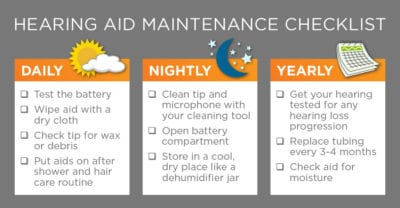Hearing aids are an investment in your quality of life and in your future, so you want them to work for as long as possible. That’s why proper hearing aid maintenance and care is so important. The better care you take of your hearing aids, the longer they will remain in proper working order. Understanding how to clean and maintain your hearing aids is very important, but you also should be aware of how often each step needs to be done in order to get the maximum benefit from your hearing aid.
Daily hearing aid maintenance checklist
There are certain steps you should take every day before you even put your hearing aids on in the morning. First, wipe off the hearing aid with a dry cloth to make sure you are not introducing any buildup of dirt, dust, or wax into the ear. Second, test that the hearing aid battery is working properly and you aren’t starting the day with a low battery. Then, check the ear piece for any wax buildup that could prevent you from hearing sounds correctly. Put your hearing aids on after your shower and hair care routine in the morning, as water, hair dryers, hair spray, and other products can damage your hearing aids.
Nightly hearing aid care
When you go to bed for the evening, take your hearing aids out of your ears and shut them off. With your specialized cleaning tool, clean the tip and the microphone each night when you remove your hearing aids. Open the battery compartment and store the aids in a cool, dry place (preferably with a dehumidifier, if you have it). You may also want to remove the batteries and clean the contacts to make sure there is no dust accumulating that could interfere with the battery connection, as this will likely extend the life of your batteries.
Yearly hearing aid maintenance instructions
Much like your eyes, you should have your hearing and hearing aids tested annually to check if your hearing loss has progressed at all.
Hearing aid care on an as-needed basis
There are some care steps for your hearing aids that depend on usage, conditions, and other factors, so they should be done on an as-needed basis. For example, replace batteries regularly and before they are completely dead, as the hearing aid’s performance may fade out first or become spotty, causing you to struggle to hear. Furthermore, tubing should be replaced every three to four months or when it is cloudy, damaged, or otherwise needs replacing. Also, regularly check for moisture, especially if you have been sweating, in a humid climate, near a pool or beach, or in the rain.
Also as needed: Replace hearing aid devices
No matter how high-quality or how expensive or inexpensive, hearing aids are still technological devices that eventually lose effectiveness and will need to be replaced. However, if you need to replace your hearing aids, it doesn’t have to cost you thousands of dollars per ear.
At MDHearingAid, we offer a variety of different types of affordable hearing aids to fit your lifestyle and needs. Find out why people love our hearing aids with our customer reviews, and, if you have any questions, feel free to contact us online and we’ll be happy to answer them.
